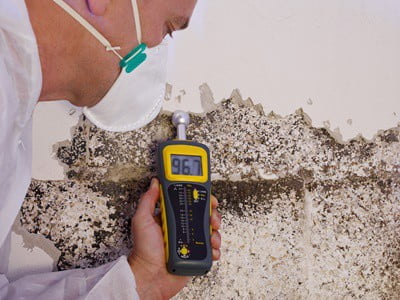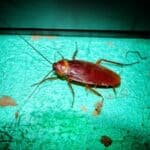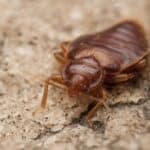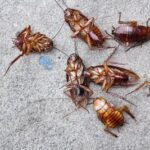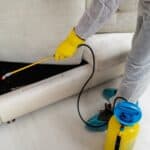Cockroaches and mold often coexist, which leads to the assumption that cockroaches do eat mold. In reality, cockroaches and mold thrive in the same environment and eat the same food. Both love warm, dark, and damp spaces and will expand their reach with these conditions. For this reason, finding mold often means that cockroaches are not far away, and vice versa.
Cockroaches don’t eat mold, but they eat the same foods. Mold grows on all sorts of matter and begins breaking it down. This makes foods that are otherwise difficult for cockroaches to eat more palatable. Given that mold thrives in the same environmental conditions that cockroaches require, these pests will sniff out mold growths. The musty scent of mold acts as a homing beacon for cockroaches and will draw them to your home.
Cockroaches can also act as hosts to mold spores. Much like how bees carry pollen around, cockroaches can carry mold spores to new locations. Mold can grow on cockroaches themselves without causing any harm to their bodies. However, cockroaches often carry mites that will eat mold. With these creatures, there is a symbiotic relationship, unlike the relationship between cockroaches and mold.
Are Cockroaches Attracted To Mold?
Cockroaches are attracted to mold, but not because it is a source of food. The mold itself is a living organism that needs food and water to survive. The ideal environment for most types of mold is also near-identical to that needed by cockroaches, which these pests have learned.
Mold thrives in damp, dark, and warm places. It will grow on and eat anything organic. Thus, the presence of mold indicates the availability of moisture and food.
As noted by Applied Mechanics and Materials, roaches have a good sense of smell. It is this that allows cockroaches to detect mold growths, even from a distance. Mold produces MVOCs, which are microbial volatile organic compounds. As the Journal of Allergy and Clinical Immunology states, these compounds cause the musty odors of mold.
Aside from telling cockroaches that there are food and water available, mold begins breaking down whatever it grows upon. This makes it far easier for cockroaches to eat and process. Mold can even soften matter that is difficult for cockroaches to eat. Other insects, like beetles and mites, are attracted to mold and fungus for the same reason.
Cockroaches will actively seek out places that are dark and damp. As you will have realized, these places are where mold thrives. In established cockroach colonies, mold will often spawn and feed off dead cockroaches, feces, and shed skins. Mold and cockroaches go hand in hand, and one will eventually draw the other.
Do Cockroaches Like Mold?
Roaches do appear to like mold. There’s no reason for them to avoid it and every reason to seek it out. They’ll live side by side with mold growths and show no indication of harming or deterring mold. For this reason, cockroaches have an almost symbiotic relationship with mold.
Cockroach nymphs also thrive in moldy environments. That’s because mold can create more food resources for insects. Mold can break down paper, cardboard, and paint to the point where fragile nymphs can readily feast.
Mold can even damage furniture and objects. This can develop into gaps or holes that roaches will leverage. They can sneak into your home, better nest in walls or chairs, and access homes through shared apartment walls.
Does Mold Kill Cockroaches?
Mold is known for coming in many varieties, some of which are toxic. A logical assumption would be that certain types can even kill the ever-resilient cockroach. While that may be possible, there is no scientific proof of this.
Theoretically, if a cockroach were to have an open wound, mold spores could infect its fragile innards. In this case, mold could eventually kill the cockroach. However, scientists have yet to explore, test, or confirm it.
Will Getting Rid of Mold Deter Cockroaches?
Targeting mold can drive out a roach infestation as it will deprive them of food and shelter. However, that can be complicated since roaches and mold support each other. Getting rid of mold starts by eliminating the cockroaches.
Handle The Roaches
Depending on the size of the cockroach population, you may need to turn to a pest control agency. Professionals also have equipment and chemicals that can get into crawl spaces and attics. These are places that roaches love to nest and breed. No matter how you cull the cockroaches, be sure to clean up:
- The dead roaches
- Any remaining feces
- Eggs
- Molted skins
Mold will grow on and consume all sorts of decaying matter, including bodies and feces.
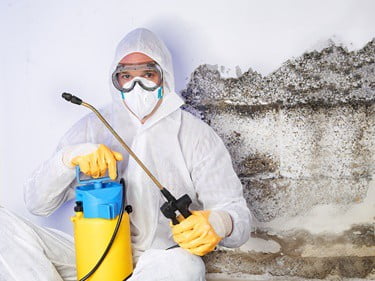
Remove Mold
Once all of the cockroaches have been eradicated, it’s time to get rid of the mold. Some pest control experts also provide limited mold removal services. This can be handy if you are sensitive to chemicals or the mold is growing in tough-to-reach spaces. Otherwise, get yourself some chemical or natural cleaners, whichever you prefer.
- Wipe and scrub down all surfaces with mold using these cleaners.
- Wipe down nearby surfaces as a preventative measure. Mold spores can be disturbed during cleaning.
- You may have to dispose of contaminated or damaged objects, like cardboard boxes and stacks of paper.
Mold spores are airborne, and some can cause respiratory distress. Wear a mask and gloves for safety during this process, especially if you are asthmatic. Even if you didn’t utilize the services of a pest control company for killing the cockroaches, there are many similar services for mold removal.
Keeping The Problem Away
After killing off the cockroaches and mold, all further measures are about prevention. Mold and cockroaches need moisture to survive. In fixing leaks in your roof and plumbing, or other damp sources, you are depriving them of this essential resource. In severe cases or places with high humidity, a dehumidifier may be necessary.
Does Mold Grow On Cockroaches?
Consider the environments that cockroaches live in and their proximity to mold colonies. It isn’t surprising that roaches host mold cultures too. A study on Madagascar hissing cockroaches found that they host many types of mold. Symbiosis found several common mold and fungi on the cockroaches studied, including:
- Trichoderma
- Aspergillus
- Rhizopus
- Cladosporium
- Geotrichum
- Mucor
- Alternaria
- Penicillium
In the wild, these cockroaches also host mites. This is a symbiotic relationship, as the mites eat molds, fungi, and parasites that can harm the cockroach.
Wild cockroaches may also host mold spores. In this manner, cockroaches act somewhat like how bees do for flower pollination. They spread the mold to other locations.
Cockroaches that do not clean themselves, or have an open wound, may see the mold grow on and within it. As roaches can carry mold spores, these pests may be the cause of mold growth in your home.
Is Mold A Sign of Cockroaches?
Mold in damp places can be a sign of cockroaches. It can also be a warning sign that cockroaches will soon be arriving, and it is time to act. Mold will grow independent of cockroaches’ presence if the setting is right. However, mold on walls, floors, or corners is a sign that there is an excess of moisture.
Deterring roaches relies upon making your home as unappealing as possible. The main means of doing this is by depriving them of access to water and food. An exterminator will be able to point out any areas that will act as hot spots for roaches. However, any place dark, damp, and warm will be ideal for cockroaches. This could mean:
- Cupboards under sinks
- Under electric appliances
- In corners with water damage
- Where pipes are damaged and leaking water.
Cockroaches are a pest that many of us struggle to eradicate. Mold growths are often seen alongside cockroach populations. That’s because mold leeches a smell that cockroaches are drawn to, as it is an indicator of food, shelter, and moisture. Mold also thrives on the same elements and will often spring up independent of roaches. That is if the cockroach didn’t carry the mold spores itself.
Exterminating cockroaches and eliminating all mold is key in preventing repeat infestations. One will eventually draw the other. Regular cleaning and resolving any water leaks will go a long way to stopping mold from regrowing.
